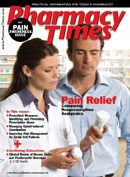Publication
Article
Pharmacy Times
Case Studies
Author(s):
Dr. Coleman is an assistant professor of pharmacy practice and director of the pharmacoeconomics and outcomes studies group at the University of Connecticut School of Pharmacy.
They Often Travel Together

NG, a 21-year-old college student, presents to an urban sexually transmitted disease clinic complaining of burning and spontaneous, purulent urethral discharge. He admits to having unprotected sex about a week ago. NG’s doctor makes the diagnosis of gonococcal urethritis and explains to him that an injection of an antibiotic called ceftriaxone (125 mg) will be needed to cure the infection. A few minutes later, a nurse returns, administers the injection, and hands NG a prescription for doxycycline 100 mg twice daily for 7 days. Somewhat confused, NG takes the prescription and brings it to the pharmacy to be filled. NG explains to the pharmacist that he was just treated for gonorrhea with “a shot of antibiotics” and asks, “Why do I need to take more antibiotics? Won’t the shot work?”
How should the pharmacist respond?
Menstrual Pain

PN comes to the counter seeking advice with his 14-year-old daughter who has been experiencing dull pain in her lower abdomen. PN brings aspirin, ibuprofen, and acetaminophen to the counter and asks which is best for his daughter. The daughter mumbles something about her friend using Midol and wonders if that would be better. Upon questioning by the pharmacist, the daughter states that her period started yesterday and that this “crampy” pain is worse during the first 2 days of her period. She also notes that she is not sexually active and that similar symptoms have occurred right around the time of her period for the last 4 months.
What advice should the pharmacist provide?
ANSWERS
CASE ONE:
The pharmacist should reassure NG that the antibiotic injection he received is 99% effective in curing gonococcal urethritis; however, it is common for patients with gonorrhea to have a concurrent chlamydial infection (C trachomatis) as well (in many areas >20% of the time). The pharmacist should explain to NG that although it is not known whether he has chlamydia, it is common practice to treat for it because he was diagnosed with gonorrhea. The pharmacist also should reassure NG that doxycycline is a recommended drug for this purpose and remind him of the importance of taking all of the antibiotic.
CASE TWO:
Based upon her symptoms (continuous, dull pain and cramping occurring at the onset of menstruation and lasting up to 72 hours), the daughter is likely suffering from primary dysmenorrhea. Although the exact cause of primary dysmenorrhea is unclear, it is thought to be associated with elevated prostaglandin levels, which cause strong uterine contractions, significant vasoconstriction, and pain. Whereas primary dysmenorrhea can be treated with aspirin, acetaminophen, or nonsteroidal antiinflammatory drugs, the latter class is most efficacious, likely as a result of its superior ability to inhibit arachidonic acid production of prostaglandins. In addition, aspirin should not be used in patients <18 years of age, due to the risk of Reye’s syndrome. Therefore, ibuprofen 200 to 400 mg every 4 to 6 hours (maximum: 1200 mg/day) taken on a schedule (not as needed) would be the best choice for this patient. Nonpharmacologic recommendations may include topical heat and regular exercise.
<!--function showAnswer() {document.getElementById("answer").style.display = 'block';document.getElementById("link").style.display = 'none';}// -->







